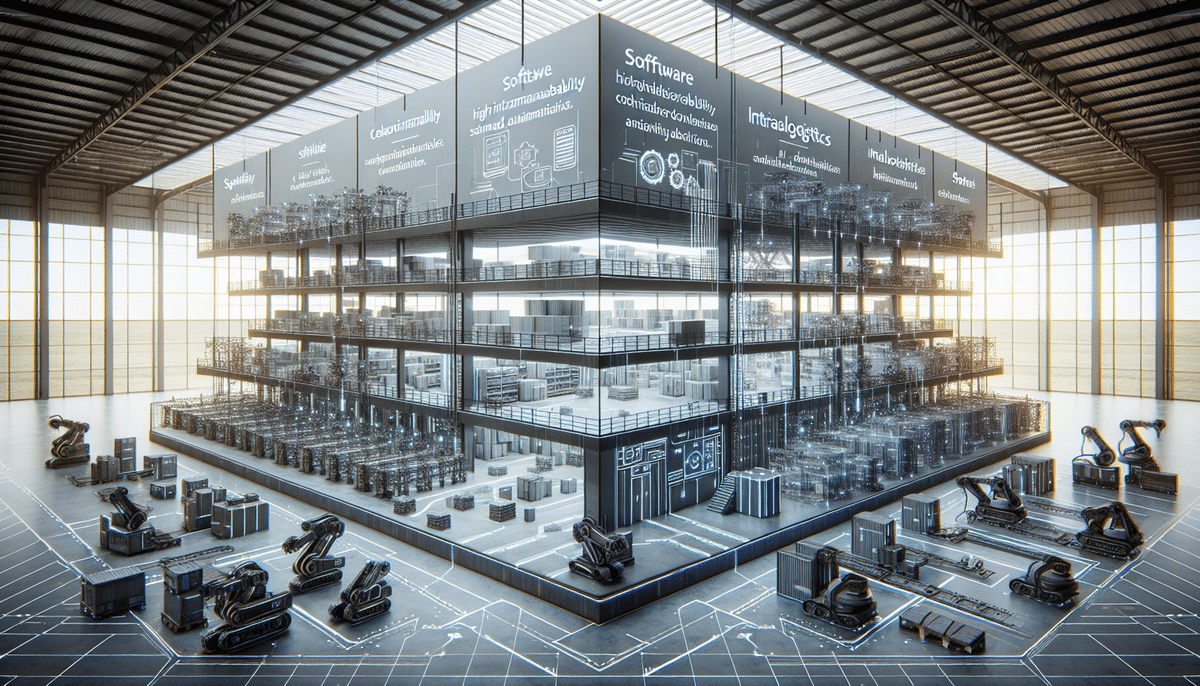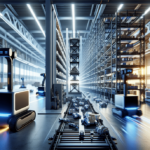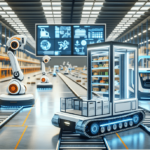Introduction to Robotic Automation in Logistics
In today's competitive market, businesses must ensure efficiency and agility within their supply chain and logistics operations. Robotic automation for material handling has become a crucial solution to overcome these challenges and enhance productivity. This article provides an in-depth analysis of two leading players in this field: Dematic and Fetch Robotics. By exploring their unique features and benefits, you can determine which solution best aligns with your business needs.
Key Players: Dematic and Fetch Robotics
Dematic: Solutions and Advantages
Dematic is a global leader in automated material handling systems, with a history dating back to 1819. The company offers a comprehensive range of solutions including Automated Guided Vehicles (AGVs), conveyor systems, and Automated Storage and Retrieval Systems (ASRS). These solutions are designed to optimize warehouse operations, enhance efficiency, and reduce operational costs.
Dematic's advanced AGVs are engineered for seamless integration with existing warehouse infrastructure, ensuring rapid and accurate transport and sorting of products. Their ASRS solutions provide secure and efficient storage, minimizing the risk of damage and errors. Additionally, Dematic offers sophisticated software and control systems such as Warehouse Management Systems (WMS), Labor Management Systems (LMS), and Transportation Management Systems (TMS) to provide real-time visibility and control over warehouse activities.
Fetch Robotics: Solutions and Advantages
Fetch Robotics is a prominent player in the field of collaborative robots (cobots), established in 2014. The company specializes in Autonomous Mobile Robots (AMRs) that work alongside human workers to boost efficiency and productivity in warehouses and supply chains. Fetch Robotics offers a variety of customizable AMRs equipped with advanced sensors and software to meet diverse operational requirements.
A standout feature of Fetch Robotics' AMRs is their adaptability to dynamic environments. Utilizing cutting-edge mapping and localization technologies, these robots can navigate complex warehouse layouts, avoid obstacles, and adjust their routes in real-time. This makes them ideal for bustling warehouse settings where inventory levels and layouts frequently change. Learn more about Fetch Robotics Solutions.
Comparative Analysis: Dematic vs Fetch Robotics
Performance and Reliability
Dematic is renowned for its durable and high-performance solutions, making it a dependable choice for large-scale operations across various industries such as automotive, food and beverage, and e-commerce. Their extensive experience and robust systems ensure consistent performance and reliability.
In contrast, Fetch Robotics excels in flexibility and adaptability. Their AMRs are designed to handle dynamic environments, making them suitable for businesses that experience frequent changes in operations. Fetch Robotics' focus on innovation and research has positioned them as leaders in the collaborative robotics space.
Integration and Scalability
Both Dematic and Fetch Robotics offer scalable solutions that can grow with your business. Dematic's systems integrate seamlessly with existing warehouse management software, providing comprehensive control and visibility. Fetch Robotics, with its cloud-based platform, facilitates easy integration with current systems and offers real-time data analytics to optimize operations.
While Dematic may require a more substantial initial investment, their long-term reliability and performance can lead to significant savings by reducing maintenance costs and minimizing downtime. On the other hand, Fetch Robotics provides cost-effective solutions initially, with the added benefit of scalability to adjust to changing business needs.
Cost-Effectiveness and ROI Considerations
The investment in robotic automation systems varies based on factors such as warehouse size, the number of robots required, and the level of customization. Generally, Dematic solutions involve higher upfront costs but offer greater return on investment (ROI) over time due to their durability and reliability. According to a report by McKinsey & Company, companies implementing Dematic's automation solutions have experienced significant reductions in operational costs and increased throughput.
Fetch Robotics solutions are more cost-effective initially, making them accessible for businesses looking to adopt automation without large capital expenditures. Additionally, their scalable and adaptable nature allows businesses to expand their robotic fleets as needed, ensuring that the automation infrastructure aligns with operational growth and demands. However, businesses should consider potential additional costs related to maintenance and upgrades as technology evolves.
Conducting a thorough cost-benefit analysis is essential to determine which solution aligns best with your financial and operational objectives. Factors such as long-term savings, potential for scalability, and the specific needs of your operations should be taken into account.
Pros and Cons of Robotic Automation
Adopting robotic automation in your business offers numerous benefits, including:
- Increased Productivity: Robots can perform tasks faster and more consistently than humans, leading to higher output.
- Reduced Labor Costs: Automation minimizes the need for manual labor, resulting in lower payroll expenses.
- Improved Accuracy and Efficiency: Robots operate with high precision, decreasing error rates and enhancing overall efficiency.
- Enhanced Safety: Automation reduces the risk of workplace injuries by handling hazardous and repetitive tasks.
However, there are also challenges and considerations to keep in mind:
- Implementation Costs: The initial investment in robotic systems can be substantial, especially for comprehensive solutions.
- Technical Expertise: Operating and maintaining robotic systems may require specialized skills and training.
- Workforce Impact: Automation can lead to job displacement, necessitating workforce retraining and management strategies.
- Integration with Existing Systems: Ensuring compatibility with current operations can be complex and may require significant adjustments.
Careful evaluation of your business needs, goals, and the potential ROI is crucial before deciding to adopt robotic automation. Pilot programs and consultations with providers can help mitigate risks and ensure a smooth transition.
Future Trends in Robotic Automation
The future of logistics is set to be significantly shaped by advancements in robotic automation. Emerging technologies such as Artificial Intelligence (AI), Machine Learning (ML), and the Internet of Things (IoT) are driving the development of more intelligent and autonomous robots capable of performing complex tasks alongside humans.
We can expect greater integration of robot-human collaboration, where robots handle repetitive and physically demanding tasks while humans focus on strategic and creative roles. This synergy will enhance overall productivity and lead to more efficient and resilient supply chain operations.
Innovations like predictive maintenance, real-time data analytics, and enhanced connectivity will enable logistics operations to become more proactive and adaptive. As robotic technologies continue to evolve, businesses will increasingly leverage these tools to gain a competitive edge, optimize their operations, and deliver superior customer experiences.
Case Studies: Dematic and Fetch Robotics in Action
Several prominent brands have successfully implemented robotic automation to enhance their warehouse and supply chain operations:
- DHL Supply Chain: Implemented Dematic's AGVs and ASRS in their pharmaceutical and medical device distribution centers. This led to a significant increase in throughput and productivity, reducing order fulfillment times by 20%.
- Adidas: Adopted Fetch Robotics' AMRs to streamline their e-commerce warehouse operations. The implementation improved picking accuracy by 15% and accelerated order processing times, enhancing overall customer satisfaction.
- Amazon: Utilizes a combination of Dematic and Fetch Robotics solutions across various fulfillment centers to manage inventory, automate sorting, and optimize delivery processes. This integration has been instrumental in maintaining Amazon's reputation for rapid and reliable delivery services.
These case studies demonstrate the tangible benefits of adopting robotic automation, including increased efficiency, reduced operational costs, and improved service quality.
Conclusion and Key Takeaways
Choosing between Dematic and Fetch Robotics depends on the unique needs and goals of your business. Here are the key points to consider:
- Reliability and Performance: Dematic offers robust and high-performance solutions ideal for large-scale and standardized operations.
- Flexibility and Adaptability: Fetch Robotics provides flexible and adaptable solutions suitable for dynamic and evolving environments.
- Cost Considerations: Dematic may have higher upfront costs but offers long-term reliability, while Fetch Robotics is more cost-effective initially with scalable options.
- Integration and Scalability: Both providers offer scalable solutions, but Fetch Robotics excels in seamless integration with existing systems and ease of deployment.
- Support and Services: Evaluate the level of customer support, training, and after-sales services each provider offers to ensure smooth implementation and ongoing operations.
Ultimately, the decision should be based on a thorough evaluation of your operational requirements, budget constraints, and strategic objectives. Consulting with both providers, assessing your workflows, and conducting a feasibility study can provide further clarity and aid in making an informed choice.
In conclusion, robotic automation is revolutionizing the logistics industry, and both Dematic and Fetch Robotics are at the forefront of this transformation. Understanding the distinct features and advantages of each provider empowers you to make an informed decision, ensuring that your business leverages the right technology to enhance efficiency, reduce costs, and improve customer satisfaction.






















